 |
| Purple/blue flowers places Comfrey in the Borage family. |
As it turns out, Bocking 14 Comfrey is a superior variety for composting tea. It is fast growing, very high in nutrients and does not set seed nor does it have a creeping root system that will take over your garden. Once established, its leaves can be cut three to four times a year, with the final harvest in the fall. I have it planted next to my cold frames.
Liquid Comfrey tea is made by steeping the cut, bruised leaves (whack ‘em on a tarp with a hoe or crush the leaves by hand if used in smaller quantities) in a container of water. As the leaves rot down, add more leaves with more water. The result is an extremely stinky, putrid brew (hold your nose, folks) rich in nitrogen and phosphorus and particularly high in potash. The leaves are also full of silica, calcium, iron, magnesium and other essential nutrients to help your fruiting plants thrive. If you want to go and get all detailie about it, here's an article about the many uses and plant nutrients in Comfrey. There are several videos on the subject on YouTube.
Usually ready within 2 weeks after the first cut, apply as a 10% solution, or roughly 1-2 cups per gallon of water. I have it fermenting in a 5 gallon bucket. If you have a lot of it, use a rain barrel with some chicken wire on the bottom to access the liquid without clogging the spigot with slime. Keeping the lid loose, lets air in to help with the process. Some folk may even advocate a small fish tank pump to oxygenate the solution, as research has shown that compost tea is more effective when air is circulated through, although most recipes do not call for aeration. Perhaps that would tamp down the odor some. Other than that, one simply adds more water when adding more Comfrey, which also adds more oxygen anyway.
Another method is to simply place cut up leaves in a bucket with a weight on them. The leaves decompose into a black goo that is diluted 15:1, water to goo. This reminds me of making sauerkraut but instead you could call it comfreykraut, I guess.
 |
| Bocking 14 fermenting away in a bucket. |
Just 3 starts has given me enough Comfrey to keep my garden going well. Being a tuberous perennial herb, these plants should last for many years. I found Bocking 14 Comfrey mail order at Horizon Herbs out of Oregon.

A natural latex mattress is far better in quality when it comes to comfort as it is made from natural products of rubber trees. truck mattress
ReplyDelete